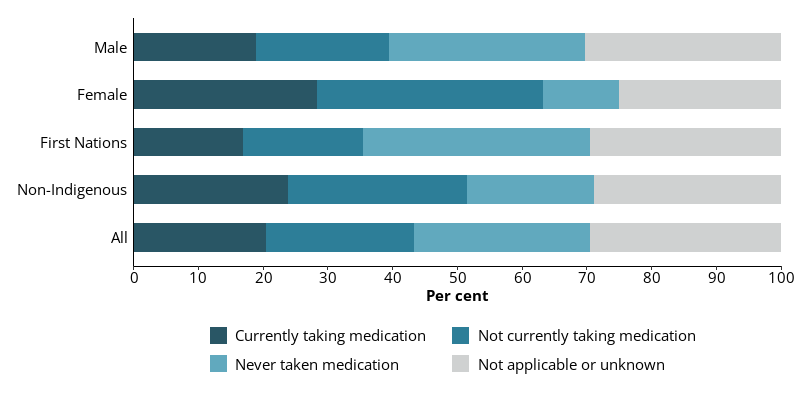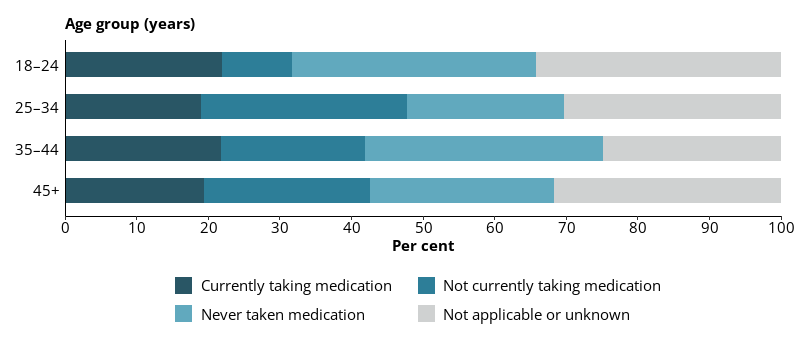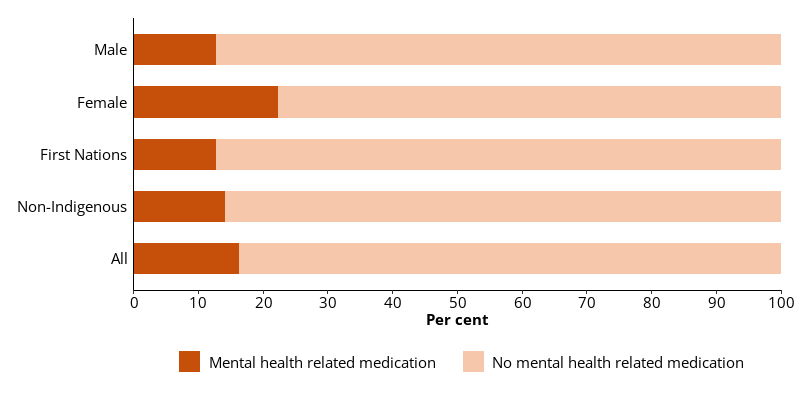Mental health medication
Medications for mental health conditions, known as psychotropic medications, include antidepressants and mood stabilisers, anti-anxiety medications, antipsychotics, sedatives and hypnotics. People in prison are more likely to be prescribed psychotropic medications than people in the general community (Spittal et al. 2019).
A study of people in prison in the United States found that 18% were taking psychotropic medication at the time of their admission to prison (Gonzalez and Connell 2014). Rates of psychotropic medication prescribing in prisons in England were found to be 5.5 times as high for males, and 5.9 times as high for females as rates for the general population of a similar age (Hassan et al. 2014).
Females in contact with the prison system in Australia are more likely than males to have been prescribed psychotropic medication. A study of female dischargees in New South Wales found that around a half had a current prescription for psychotropic medication (Abbott et al. 2016).
Mental health medication for prison entrants
Prison entrants were asked whether they currently have a mental health or behavioural condition (for more information see Mental health and self-harm). They were then asked if during the past 12 months they received treatment for a mental health or behavioural condition, and if they have ever taken medication for a mental health disorder.
One in 5 (20%) entrants reported currently taking medication related to mental health. Female entrants (28%) were more likely than male entrants (19%) to report taking mental health related medication (Figure 12.2).
Non-Indigenous entrants (24%) were more likely than First Nations entrants (17%) to report currently taking medication for a mental health condition (Figure 12.2).
Figure 12.2: Prison entrants currently taking mental health related medication, by sex and Indigenous identity, 2022

Notes
- Proportions are representative of this data collection only, and not the entire prison population.
- Excludes Victoria, which did not provide data for this item.
Source: Entrants form, 2018 NPHDC.
Prison entrants aged 18–24 and 35–44 (22%) were equally as likely to report currently taking medication for a mental health condition, and those aged 25–34 (19%) were the least likely (Figure 12.3).
Figure 12.3: Prison entrants currently taking mental health related medication, by age, 2022

Notes
- Proportions are representative of this data collection only, and not the entire prison population.
- Excludes Victoria, which did not provide data for this item.
Source: Entrants form, 2022 NPHDC.
Mental health medication dispensed to people in custody
Due to the many comorbidities in the area of mental health alone, some people were dispensed medications from multiple categories.
Some medications may also be prescribed for conditions other than the primary condition for which the medication was originally designed to treat. For example, some antipsychotic medications may be prescribed in low doses to treat insomnia while some antiepileptic medications are commonly prescribed to treat neuropathic pain (Murnion 2018; Thompson et al. 2016). As well, not all medications regularly dispensed were reported, so the proportions are likely under-representative of the true values.
About 1 in 6 (16%) people in custody were dispensed mental health related medication. Females in prison (22%) were more than 1.5 times as likely as males (13%) to be dispensed mental health related medication (Figure 12.4).
There was no difference in the proportion of First Nations people in custody (13%) and non‑Indigenous people in custody (14%) taking prescribed mental health related medication.
Figure 12.4: People in custody, dispensed mental health related medication, by sex and Indigenous identity, 2022

Notes
- Proportions are representative of this data collection only, and not the entire prison population.
- Excludes Victoria, which did not provide data for this item.
Source: ABS 2023; Medication form, 2022 NPHDC.
People in custody aged 35–44 (18%) were the most likely to be dispensed mental health related medications, while those aged 18–24 (10%) were the least likely.
The majority of mental health related medications dispensed were antidepressants, regardless of age, sex or Indigenous status. Antidepressants accounted for almost 1 in 5 (18%) of all mental health related medications dispensed during the 2022 collection period.
One in 15 (6.8%) mental health related medications dispensed were antipsychotics, while hypnotics and sedatives (0.6%) and anti-anxiety medications (0.4%) were dispensed in small amounts only.
Females in custody (20%) were slightly more likely to be dispensed antidepressant medications than males in custody (18%). Similarly, females (7.6%) were slightly more likely than males (6.5%) to be dispensed antipsychotic medications.
Abbott P, Magin P and Hu W (2016) ‘Healthcare delivery for women in prison: a medical record review’, Australian Journal of Primary Health, 22(6):523–529.
Gonzalez JMR and Connell NM (2014) ‘Mental health of prisoners: identifying barriers to mental health treatment and medication continuity’, American Journal of Public Health 104.
Hassan L, Senior J, Frisher M, Edge D and Shaw J (2014) ‘A comparison of psychotropic medication prescribing patterns in East of England prisons and the general population’, Journal of Psychopharmacology, 28:357–362.
Murnion BP (2018) ‘Neuropathic pain: current definition and review of drug treatment’, Australian Prescriber, 41(3):60–63.
Spittal MJ, Forsyth S, Borschmann R, Young JT and Kinner SA (2019) ‘Modifiable risk factors for external cause mortality after release from prison: a nested case-control study’, Epidemiology and Psychiatric Sciences, 28(2):224–233, doi:10.1017/S2045796017000506.
Thompson W, Quay TAW, Rojas-Fernandez C, Farrell B and Bjerre LM (2016) ‘Atypical antipsychotics for insomnia: a systematic review’, Sleep Medicine, 22:13–17


